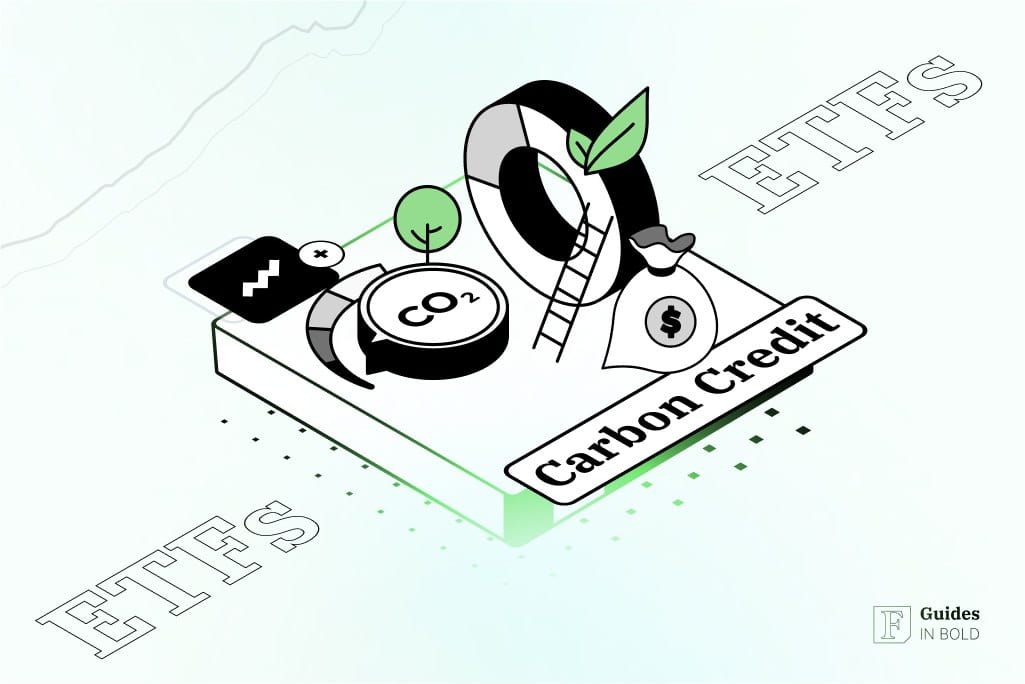Summary: Due to the ongoing global scramble to reduce carbon emissions, a new carbon credit system has gained traction, and a potentially lucrative new market has emerged for eco-aware investors. This guide will showcase some of the best-performing carbon credit ETFs and how to invest in them using a regulated online brokerage like Interactive Brokers.
Best Platform for Worldwide Stock Trading & Investing
-
Highly trusted multi-asset broker with clients in over 200 countries
-
Trade on 150 markets globally from a single platform (stocks, ETFs, futures, currencies, crypto & more)
-
Low commissions starting at $0 with no platform fees or account minimums
-
Easily fund your account and trade assets in 26 currencies
-
IBKR pays up to 4.58% interest on cash balances of $10k or more
What are carbon credit ETFs?
It has been decades since our society acknowledged carbon emissions as one of the primary threats to the ecological standing of our environment. However, coming up with the most efficient and economically viable ways to reduce carbon emissions has proved challenging.
One of the proposed solutions is the introduction of carbon offsets and carbon credits.
Carbon offsets are measures compensating for emissions of carbon dioxide or dioxide-equivalents, with one unit of carbon offset equalling the removal of one tonne of carbon emissions elsewhere. Furthermore, carbon offset projects, such as renewable energy, energy efficiency, and tree planting, allow individuals and companies to fund efforts that counterbalance their own carbon emissions.
Carbon credits are a type of environmental commodity. When a business or individual invests in carbon offset programs, they receive carbon credits. These credits are traded on carbon markets with the total number of credits capped to limit overall emissions.
Companies that overextend carbon emission limits could obtain carbon credits to reach their net emission goals without penalties. As net-zero emission goals and deadlines approach, carbon offsets and credits could become exponentially more valuable, and the carbon market has already reached $10 billion in 2022.
About
In the wake of the ongoing carbon footprint reduction, increased sustainability, and rising environmental consciousness trends, investing in carbon credit ETFs could provide significant returns in the future.
3 Best carbon credit ETFs for 2025
After exhaustive research, we present to you a selection of top three carbon credit ETFs:
- KraneShares Global Carbon Offset Strategy ETF (NYSE Arca: KSET);
- Global X Carbon Credits Strategy ETF (NYSE Arca: NTRL);
- iPath Series B Carbon ETN (NYSE Arca: GRN).
Note
Best Platform for Worldwide Stock Trading & Investing
-
Highly trusted multi-asset broker with clients in over 200 countries
-
Trade on 150 markets globally from a single platform (stocks, ETFs, futures, currencies, crypto & more)
-
Low commissions starting at $0 with no platform fees or account minimums
-
Easily fund your account and trade assets in 26 currencies
-
IBKR pays up to 4.58% interest on cash balances of $10k or more
1. KraneShares Global Carbon Offset Strategy ETF (KSET)
KraneShares Global Carbon Offset Strategy ETF (NYSE Arca: KSET) is a carbon credit ETF that reflects the performance of the S&P GSCI Global Voluntary Carbon Liquidity Weighted Index. KSET gives investors access to these futures contracts and provides instruments to speculate on the rising global voluntary emissions market. In other words, the fund tracks a broad voluntary carbon market portfolio of carbon offset futures contracts.
KraneShares Global Carbon Offset Strategy ETF price today
Your capital is at risk.
2. Global X Carbon Credits Strategy ETF (NTRL)
Global X Carbon Credits Strategy ETF (NYSE Arca: NTRL) is a carbon credit ETF that aims to give exposure to several emissions trading schemes worldwide by pursuing some of the most popular carbon credit futures. Its holdings are located across various geographies, with the ultimate aim of capping emissions in accordance with the 2015 Paris Agreement.
NTRL takes long positions in cap-and-trade regimes across the EU, the UK, the alliance of Northeastern U.S. states, and California. It seeks to approximately match the price and yield of the ICE Global Carbon Futures Index, notwithstanding fees and expenses.
Global X Carbon Credits Strategy ETF price today
Your capital is at risk.
3. iPath Series B Carbon ETN
iPath Series B Carbon ETN (NYSE Arca: GRN) is a carbon credit ETF designed to give exposure to the Barclays Global Carbon II TR USD Index. The fund aims to reflect the price of carbon indicated by the return of futures contracts, according to the EU Emission Trading Scheme and the Kyoto Protocol’s Clean Development Mechanism. It is comprised almost entirely of the futures contracts on carbon emission credits in the EU, which is reflected in the fact that the Index Components are denominated in euros, while the index is traded in U.S. dollars.
iPath Series B Carbon ETN price today
Your capital is at risk.
How to invest in carbon credit ETFs: Step-by-step
If you are curious about how to invest in carbon credit ETFs, follow our step-by-step guide for a quick and straightforward explanation.
Step 1: Choose a broker
Before investing in carbon credit ETFs, you need to get access to the corresponding market first. Investors can simply obtain it by using a third-party investing service. The simplest and most effective option is an online brokerage.
To securely trade carbon credit ETFs, we recommend you consider Interactive Brokers (IB):
- Commission-free stock trading;
- Global stock-trading on 90+ market centers;
- Fractional shares available;
- Extra income on fully paid shares;
- Lowest financing rates for margin accounts in the industry;
- No account minimum.
Best Platform for Worldwide Stock Trading & Investing
-
Highly trusted multi-asset broker with clients in over 200 countries
-
Trade on 150 markets globally from a single platform (stocks, ETFs, futures, currencies, crypto & more)
-
Low commissions starting at $0 with no platform fees or account minimums
-
Easily fund your account and trade assets in 26 currencies
-
IBKR pays up to 4.58% interest on cash balances of $10k or more
Step 2: Open and fund your account
Once you opt for a platform, you should proceed to create and verify your account. Immediately after registering, the investing service will email you the correct instructions.
The next step is to prepare to trade carbon credit ETFs by transferring money into your account. Commonly available funding methods include bank transfers, debit or credit cards, and transaction services like PayPal.
Step 3: Decide how much you want to invest
Delineating your budget before you start trading carbon credit ETFs is crucial to your success. Keeping your investment within the budget limits should stop a potential financial disaster from happening. To allow for a stable and safe investment, make sure you have done the following:
- Paid off all high-interest debt, such as credit cards and personal loans;
- Created an emergency fund that covers at least three months of daily life expenses.
Remember
Step 4: Place your order and trade carbon credit ETFs
The next step is placing an order and conducting the trade. Go through the following:
- Step 1: Log into your account and find the desired carbon credit ETF ticker;
- Step 2: Type in the amount you wish to purchase;
- Step 3: Select the order type (market order or limit order) and place it;
- Step 4: Confirm the trade order.
Remember
Pros and cons of investing in a carbon credit ETF

Pros
- ESG goals alignment: Investing in carbon credit ETFs goes hand in hand with environmental, social, and governance (ESG) goals. These financial instruments are designed to support environmentally friendly projects and activities;
- Diversification: Adding carbon credit ETFs to your portfolio can offer exposure to a unique asset class that mostly does not correlate closely with traditional equity or bond markets;
- Growing market: With rising awareness of the dangers of climate change and a global push toward sustainability, the carbon credit market is projected to grow. Investing in this market early on may offer the potential for capital appreciation.

Cons
- Complexity: Carbon credit markets can be complex, and investors may not fully understand how these instruments work. Insufficient information can lead to bad investment decisions;
- Limited historical performance information: Carbon credit ETFs have limited historical performance data, making it impossible for investors to assess their long-term track record and make informed decisions based on previous performance;
- No standardization: The carbon credit market does not have a standardized framework, and the value of carbon credits can vary. This lack of standardization can hamper assessing the actual value and impact of each investment.
Consider investing in more ETFs
If you are considering additional investing in ETF commodities, you can check out our other guides on this topic, including:
- How to Invest in Gold ETFs;
- How to Invest in Silver ETFs;
- How to Invest in Lithium ETFs;
- How to Invest in Copper ETFs;
- How to Invest in Natural Gas ETFs;
- How to Invest in Wheat ETFs;
- How to Invest in Farmland ETFs;
- How to Invest in Cobalt ETFs.
Common mistakes to avoid when investing in a carbon credit ETF
Make sure to avoid these common investing mistakes:
- Lack of research: Research carbon offsets, carbon credits, and carbon credit ETFs in detail before investing;
- Lack of strategy: Set your goals before you spend any money;
- Staking everything on one asset: Always diversify your portfolio;
- Falling prey to scams: Avoid illegal platforms and suspicious deals.
Disclaimer: The content on this site should not be considered investment advice. Investing is speculative. When investing, your capital is at risk.
FAQs about how to invest in carbon credit ETFs
What is the carbon credit market?
The carbon credit market is a trading scheme where companies buy and sell carbon credits, which represent the right to emit a certain amount of greenhouse gases. This system allows businesses to trade carbon offsets to meet their emission targets, thereby promoting a reduction in overall greenhouse gas emissions.
What is a carbon credit ETF?
A carbon credit ETF is a fund that gives individual investors exposure to the carbon credit market.
What are the best carbon credit ETFs?
Our pick for the best carbon credit ETF includes the following ETFs: KraneShares Global Carbon Offset Strategy ETF (NYSE Arca: KSET), Global X Carbon Credits Strategy ETF (NYSE Arca: NTRL), and iPath Series B Carbon ETN (NYSE Arca: GRN).
How do you trade carbon credit ETFs?
Carbon credit ETFs trade just as stocks on major stock exchanges. To trade carbon credit ETFs, create an account with a reputable online brokerage like Interactive Brokers, select a carbon credit ETF, transfer some funds to your account, and place a buy or sell order through the platform.
Do carbon credit ETFs pay dividends?
Unfortunately, most ETFs, including each carbon credit ETF on this list, do not pay dividends.
Is trading carbon credit ETFs safe?
By doing your research, making solid investing decisions, and using a regulated brokerage like Interactive Brokers, you maximize the safety and success chance of your investment.




